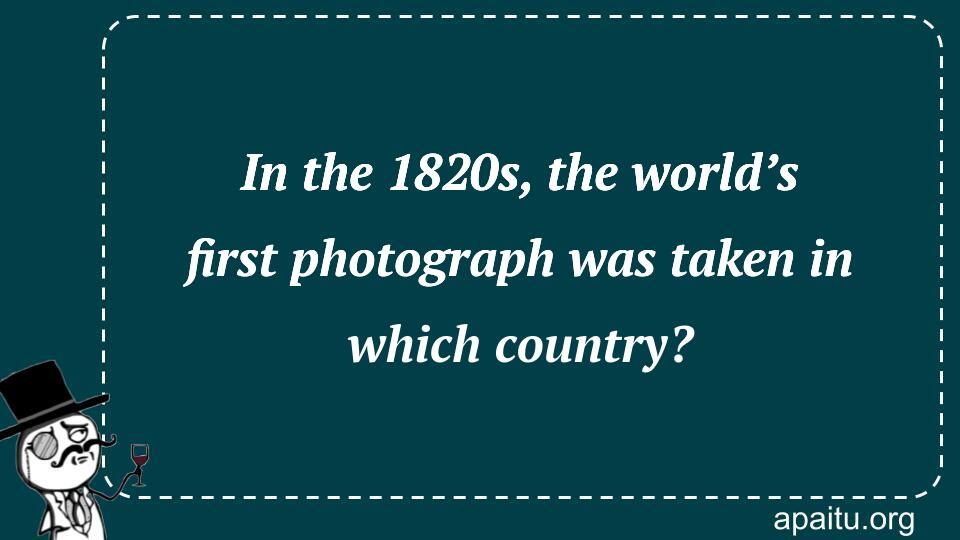Question
Here is the question : IN THE 1820S, THE WORLD’S FIRST PHOTOGRAPH WAS TAKEN IN WHICH COUNTRY?
Option
Here is the option for the question :
- France
- United States
- Japan
- Germany
The Answer:
And, the answer for the the question is :
Explanation:
Between 1826 and 1827, Nicéphore Niépce took the first known photograph, ‘View from the Window at Le Gras,’ at his family’s countryside home in Saint-Loup-de-Varennes, France. By applying varnish to a pewter plate and placing it in a camera obscura for a few hours, we were able to generate the faint shadows of a courtyard and outbuildings.

FRANCE: The Birthplace of the World’s First Photograph
In the vast and ever-evolving world of photography, there is a significant moment that marked the birth of an art form that would go on to shape the way we capture and preserve memories. In the 1820s, the world’s first photograph was taken, and it happened in none other than France. Join me as we journey back in time and explore the fascinating origins of this groundbreaking achievement, unraveling the story behind this iconic moment in the history of photography.
The year was 1826 when Joseph Nicéphore Niépce, a French inventor and pioneer in the field of photography, successfully captured the world’s first photograph. His groundbreaking achievement came after years of experimentation and a relentless pursuit of finding a way to permanently capture an image using light and chemicals.
Niépce’s pioneering technique, known as heliography, involved using a camera obscura to project the image onto a light-sensitive plate coated with bitumen of Judea, a naturally occurring asphalt. The plate was then exposed to light over an extended period, resulting in the gradual hardening of the bitumen in proportion to the intensity of the light. After the exposure, Niépce used a solvent to remove the unhardened bitumen, leaving behind a permanent image.
The photograph that Niépce captured, titled “View from the Window at Le Gras,” showcased a scene from the window of his estate in Saint-Loup-de-Varennes, France. Although the image was simple, depicting a view of buildings and rooftops, it represented a groundbreaking moment in human history. It was the first time that a permanent image had been captured using a camera and chemicals, setting the stage for the future of photography.
Niépce’s achievement laid the foundation for the development of photography as we know it today. His invention paved the way for subsequent advancements, inspiring a wave of inventors and photographers to further explore the possibilities of capturing and preserving images. From the daguerreotype to modern digital photography, the techniques and technologies that emerged from Niépce’s groundbreaking work continue to shape the art and science of image-making.
The significance of Niépce’s achievement was not immediately recognized. It was his collaboration with Louis-Jacques-Mandé Daguerre, a French artist and inventor, that ultimately brought photography into the public eye. Together, they refined the process and introduced the daguerreotype, an improved method of capturing images on a silver-coated copper plate. The daguerreotype gained widespread popularity, and its introduction in 1839 marked a turning point in the history of photography.
Niépce’s groundbreaking photograph and his contributions to the development of photography have cemented France’s place as the birthplace of this transformative art form. Today, the country continues to be a hub for artistic expression and innovation in photography, with renowned institutions and exhibitions showcasing the works of both historical and contemporary photographers.
the world’s first photograph was taken in France in the 1820s by Joseph Nicéphore Niépce. His pioneering technique and relentless experimentation led to the creation of the heliography process, allowing him to capture a permanent image using light and chemicals. This groundbreaking achievement set the stage for the development of photography as we know it today, shaping the way we capture, preserve, and appreciate the world around us. Niépce’s legacy lives on, reminding us of the power of innovation and human ingenuity in shaping our artistic and technological landscape.